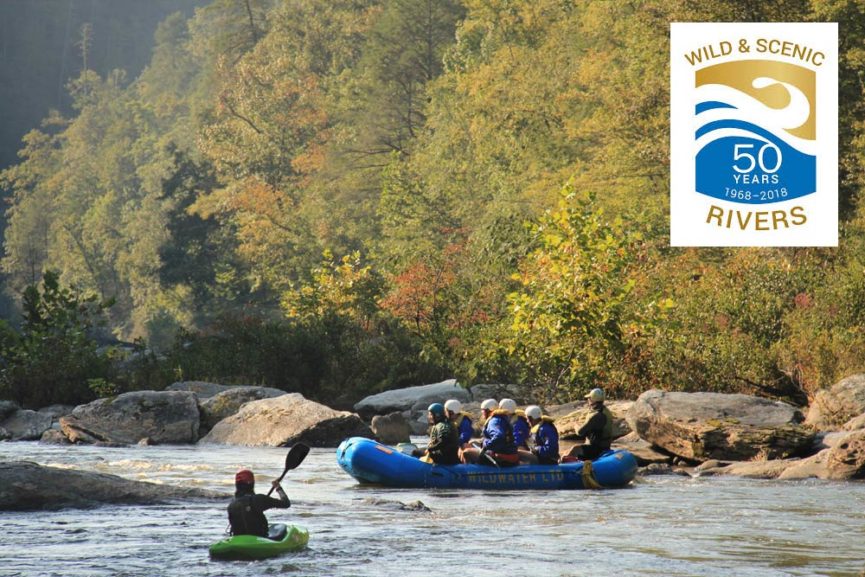Chattooga River History: Celebrating 44 Years as a National Wild and Scenic River
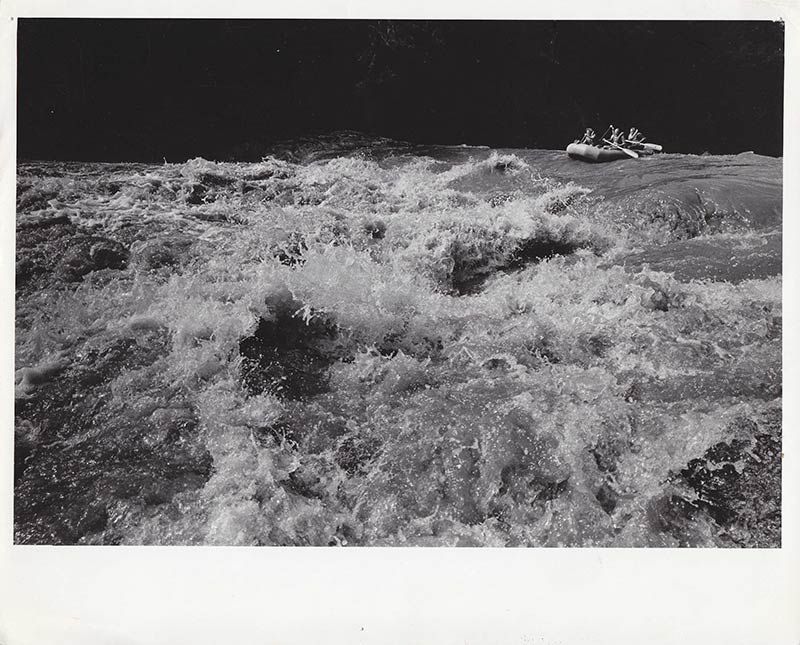
Spring 1972 -Jim and Jeannette Greiner guide Congressman Roy Taylor and his wife down the Chattooga River, part of 2 trips of public officials experiencing the Chattooga for the first time.
Forty four years ago on May 10, 1974, the Chattooga River was designated as a National Wild and Scenic River. It was just 6 years after the Wild and Scenic Rivers Act was established on October 2, 1968. The Wild and Scenic Rivers Act is celebrating its 50th Anniversary this year. We thought this was a perfect time to share some of the history behind how the Chattooga River achieved its Wild and Scenic River status. It was thanks to the efforts of many concerned citizens and the support of key public officials across three states.
Let’s understand the answers to these three questions:
- How did the Chattooga River get Wild and Scenic River status?
- What role did early advocates and river runners, including Wildwater, play in helping the Chattooga River gain Wild and Scenic designation protection?
- Where is the Chattooga River?
1971 and 1972: Key Years On Way to Wild and Scenic Designation for Chattooga River
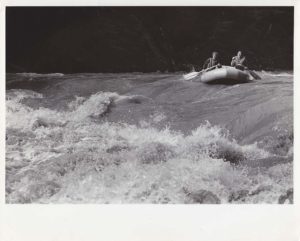
Rock Jumble, high water on the Chattooga River Spring 1972
Wildwater Ltd. , along with many other important advocates, was able to help play a wonderful support role in the efforts to get the Chattooga River protected for all future generations as a National Wild and Scenic River. Founded by Jim and Jeannette Greiner in June of 1971, Wildwater was the very first rafting company to run commercial trips on the Chattooga River. The first rafting trip with Guests took place in June 1971. This was the same year that the movie “Deliverance”, starring Burt Reynolds, Ned Beatty and Jon Voight, was filmed on the Chattooga River.
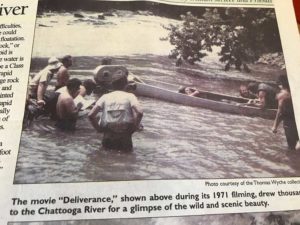
Local newspaper article on filming of Deliverance – 1971
In fact, Jim Greiner came upon the filming of the movie at the Chattooga on a visit to Georgia that summer of 1971. It was a key motivation to make him want to start his rafting company that summer! Read about the history of how Wildwater was started here. Several area river runner experts actually worked for the movie production as advisors and stunt doubles. Two of these river runners started the other two rafting companies on the Chattooga River the following year – NOC and Southeastern. Learn more about the movie filming here.
1972 was a tremendous year of awareness building for the Chattooga River and whitewater rafting in the United States because of two significant events that year:
- The movie “Deliverance” came out in July 1972 and showed Americans the thrills (and spills!) of whitewater rafting.
- 1972 was the first year that whitewater kayak and canoe slalom events were in the Olympics.
The Efforts to Get Wild and Scenic River Status for the Chattooga River
The Chattooga River is the only National Wild and Scenic River in all of Georgia and South Carolina. Congress designated the Chattooga River as a Wild and Scenic River on May 10, 1974, after dedicated efforts by many Chattooga River advocates to help federal and state officials understand why the Chattooga River was so special.
1968: Chattooga River is designated a Wild and Scenic “Study River”, at time WSRA is Established
The original Wild and Scenic River Act of 1968 designated 8 rivers as Wild and Scenic, with another 20 rivers identified as “study rivers”. The Chattooga River was selected as one of those early study rivers in 1968. In 1969, Clemson University professor Gordon Howard, also a good friend of Wildwater co-founder Jim Greiner, did the first extensive water quality study on the Chattooga River to confirm that it matched the water quality requirements for Wild & Scenic Rivers.
Where is the Chattooga River System Located? Answer: North Carolina, South Carolina and Georgia
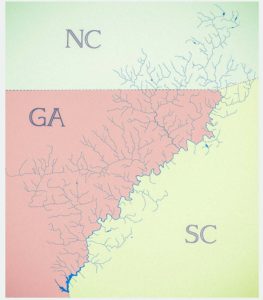
Chattooga River System Watershed – Map Courtesy of Chattooga Conservancy
The Chattooga River drains a large watershed from three states, North Carolina, South Carolina and Georgia. This impressive river system attracted Wild and Scenic advocates in all three states. Our friends at the Chattooga Conservancy have a terrific map that shows the entire watershed. Check out their website for lots more information about the Chattooga River and how you can support its ongoing protection. It’s easy to see from this map why public officials from all three states – including Congressmen, Senators and Governors to USFS Foresters and USNP Rangers became keen to protect the mighty Chattooga River.
The Chattooga River flows along the border of Georgia and South Carolina. The sections of the river that are popular for white water rafting are Section 3 and Section 4, while Section 2 is also popular for fishing. Learn more about Section 3 and 4 rafting here.
1971 Chattooga River Has First Commercial Whitewater Rafting Trip by Wildwater – Whitewater Rafting Takes Off.
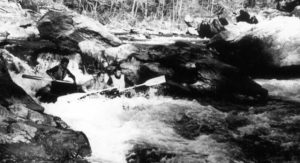
Everyone who experienced the Chattooga River in those early days immediately recognized the value and importance of protecting its wild and scenic nature for future generations. Everyone was quickly hooked on this amazing river! There’s a reason indeed that Southern Living called rafting on the Chattooga River as “The #1 Thing Every Southern Ought To Do!”.
1972- Active Promotion of River to NC, SC and GA State Government and USFS and USNP Officials Begins
Greiner’s friends Gordon Howard, a professor at Clemson University, and Ervin Jackson, a businessman & freelance journalist from Charlotte NC, along with other key figures like Payson Kennedy, Claude Terry and Doug Woodward, understood that you can only fall in love with, and protect, that which you know. The idea to invite key players on a whitewater rafting trip to experience the river for themselves was the natural next step.
Organizing the 1972 Rafting Trip for Public Officials: After All, You Can’t Save What You Don’t Know!
Ervin Jackson was instrumental in connecting the Chattooga Wild & Scenic effort to Congressman Roy Taylor of Western North Carolina. The Chattooga watershed includes North Carolina, South Carolina and Georgia. The Chattooga River itself runs on the border of South Carolina and Georgia – both states can claim the river as theirs. Ervin invited Congressman Taylor to the Chattooga to witness just how special it was and why it was such a good candidate to be the next Wild & Scenic River.
Not only did Congressman Taylor and his wife accept the invitation, Taylor started to invite others to join him to experience the Chattooga river. He included Congressman Seiberling from Ohio and two more Congressmen, including one delegate from the Virgin Islands. Gordon Howard from Clemson University helped organize the rafting trip.
The US Forest Service forester Max Peterson was also invited to attend this Chattooga River Raft Trip. Peterson was the regional forester for Region 8 in Atlanta 1972-1974. Three other Forest Service Representatives joined the trip and a National Park Service representative also joined the trip.
When it became obvious the interest in the Chattooga River rafting trip was growing and the number of influential people who were attending was increasing, Jim Greiner invited Claude Terry and Payson Kennedy to help lead the trip as well. Typically only 4-5 guests plus a guide were in each raft and the Chattooga River was a serious river requiring knowledgeable guides! The early Chattooga River rafting days were one of collegial competition and friendly support among river companies. Claude Terry and Payson Kennedy were already experienced river runners at that time in 1971. (Both worked on river scenes in the filming of the movie Deliverance, and both started their own rafting companies the following summer of 1972. Terry started Southeastern Expeditions, Kennedy started Nantahala Outdoor Center with Horace Holden, Sr.)
Ervin Jackson also invited well known and much respected reporter Kays Gary, from the Charlotte Observer, to join the trip, recognizing that press would certainly help their publicity efforts for the Chattooga River!
Claude Terry then called his friend Jimmy Carter, then Governor of Georgia, to get him behind the effort. While Governor Carter wasn’t on that spring 1972 raft trip with the congressional delegation, he did indeed fall in love with the Chattooga River. He became a key supporter of the Wild and Scenic River designation for the Chattooga River. This short video, The Wild President, by American Rivers and Yeti – offers a terrific look at how then Governor Carter was so profoundly moved by the beauty of the Chattooga River and his role in advocating for its Wild and Scenic River status.
(Did you know, former President Carter and Claude Terry made the first tandem open canoe descent of Bull Sluice in 1974? It’s true! Watch the video presented and created by NRS with Yeti and American Rivers.)
Spring 1972 The Congressional Delegation Rafts the Chattooga – It’s A High Water Adventure & Shortened Trip!
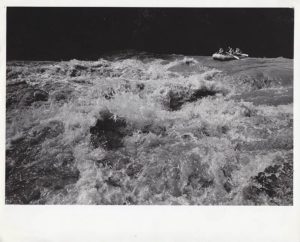
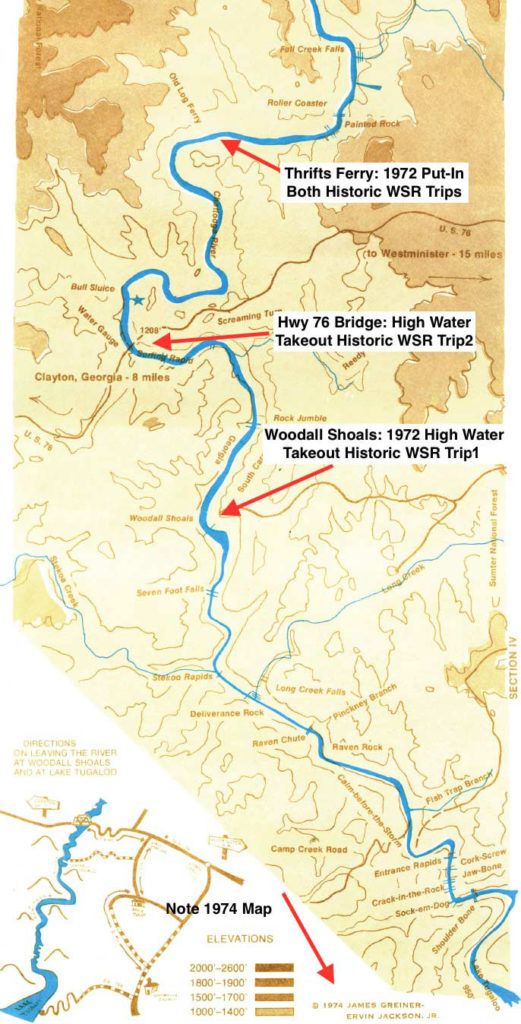
The rafting group that day was split into two smaller trips of 3 and 2 rafts each, in respect for the Wild and Scenic Nature of the Chattooga. Jim and Jeanette Greiner guided rafts on the first trip along with Terry Darby, Wildwater’s first chief guide. Claude Terry and Payson Kennedy guided rafts on the second trip.
South Carolina Senator Fritz Hollings Joins Congressional Delegation Rafting Guests in Long Creek, SC After Rafting
After the rafting trips got off the river that day, the entire group met at the Fire Department building in Long Creek, South Carolina. Long time South Carolina Senator Fritz Hollings joined the group there in Long Creek, to discuss the trip and the future of the Chattooga River.
Congressman John Seiberling from Ohio stated after the trip, “The water was so high I cannot speak to the Scenic nature of the River, but I can certainly testify it was Wild!”
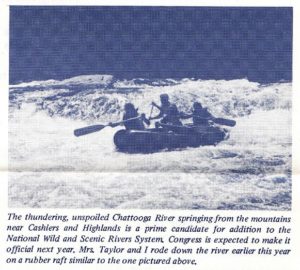
Ervin Jackson went to Washington, DC after the rafting trip to lobby on Capitol Hill for Wild and Scenic designation protection for the Chattooga River. Members of that special rafting trip joined him to support congressional action for the Chattooga. The Chattooga River did receive Wild and Scenic designation within two years of that rafting trip, on May 10, 1974. Wildwater founders Jim and Jeannette Greiner were grateful and thrilled that they were able to help play a role in achieving this wonderful Wild and Scenic designation.
Learn about what National Wild and Scenic River designation means, and answer these questions:
- What is the Wild and Scenic Rivers Act of 1968?
- What does Wild and Scenic River status actually mean for the Chattooga River?

